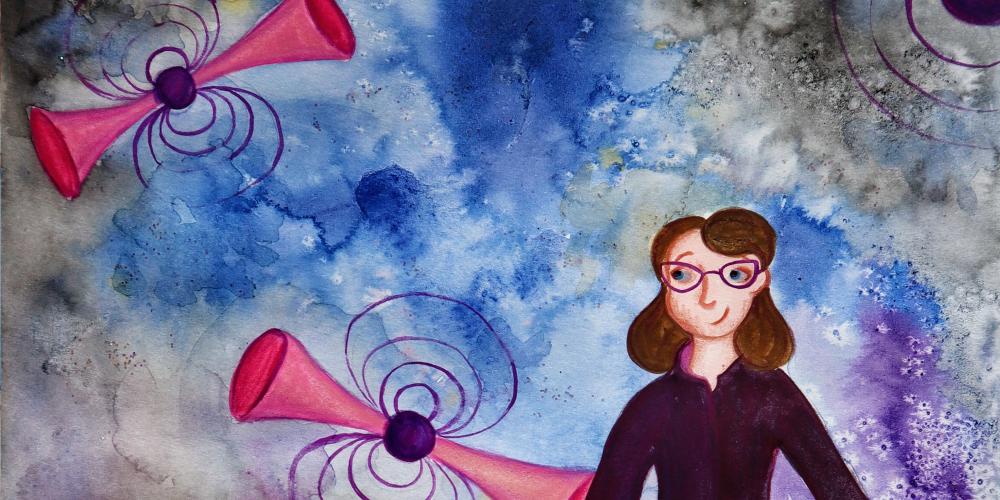
10 October, 2024
Laura Finnegan
Posted: 17 June, 2019

Laura Finnegan is a Government of Ireland Postgraduate Scholarship awardee for her research ‘Exploration of novel gene therapies for inherited retinal degenerations’. Laura is also the winner of the 2019 Mary Mulvihill Award for her illustrations on the theme ‘Science for the love of it’.
This year’s Mary Mulvihill Award ceremony was held in the Science Gallery, Trinity College Dublin, the perfect location to encapsulate my interests: I am a PhD student in the Smurfit Institute of Genetics in Trinity but also an artist and illustrator. Art school featured high up on my CAO form until I conceded that one can’t perform genetics experiments at home as easily as one can paint. I graduated with a degree in Genetics in 2017, started a PhD in Prof. Jane Farrar’s lab, and have managed to keep up my art all the way along, be it illustrating for the college paper or scientific papers, or painting for commissions or art auctions. Royalties from prints, stickers and even shower curtains contribute toward my coffee consumption!
In January, my science communication lecturer, Dr. Joseph Roche, encouraged us all to enter the Mary Mulvihill competition for science communication. Mary Mulvihill, who graduated from my department in the 80s, was a gifted science communicator with very broad interests: her degree was in Genetics, but she loved all aspects of science and technology. She was a co-founder of Women in Technology and Science Ireland and ran tours of Dublin, showing off the landmarks pertaining to our science heritage. The theme for this year’s competition was particular apt, given Mary’s character: “Science for the Love of it”. As kids we’re taught to view science with objectivity, love doesn’t really come into it. While we should remain objective in our scientific endeavours, falling in love with the science we do is often inevitable as we chip away trying to answer our most pressing questions. My entry for the Mary Mulvihill Competition was a sampler of a children’s book I’m writing about Irish Scientists—including Jane Farrar and Mary Mulvihill. I have illustrated each scientist doing what they love, alongside a summary of their story as a scientist.
My PhD, funded by an Irish Research Council Government of Ireland Postgraduate Scholarship, explores the potential use of gene therapies for retinal degeneration. The work of the Farrar lab is illustrated in the sampler of my book, an image of Jane Farrar inspecting a pedigree of an affected family while swinging from a virus delivering the “fixed” version of a gene to make up for a patient’s “broken” copy. Gene therapy is a wonderfully futuristic topic to convey to kids, and yet it is currently being used in children. The story of one child with Leber’s congenital amaurosis made me sure I wanted to study gene therapy: in my Junior Freshman year in Trinity College Dublin, Prof. Farrar showed us a video of a little boy navigating a maze without much luck. He had one eye covered. The researchers uncovered the second eye—the treated eye. He finished the maze in a flash. I was amazed; these researchers had used his genetic information to develop a therapy to prevent his retina from degenerating and saved his vision. The therapy, developed by Spark Therapeutics, is now on the market as LUXTURNA.
Stories such as these inspire and empower young minds. This year I was a PhD tutor for AccessEd, a charity that runs Scholars Ireland, an accessibility programme aiming to encourage kids from underrepresented areas to go to college. I taught 12 bright and deep-thinking girls who were just as amazed as I was when they first saw the video of the boy. They had completed a crash course in gene therapy and understood what the rationale behind my work is. On seeing the video they could imagine the end goal and connect with the individuals involved.
Through my book I want to let kids feel the excitement and passion that great scientists feel for their work, to see them as humans in love with curiosity. When I was preparing my list of scientists for the project, I came across many of Mary’s articles depicting the passion and love of some great Irish scientists for their work. Some of these people had stories as interesting as the science itself. Stories, particularly when paired with illustrations, have a great power of accessibility and engagement. While teaching kids about science is of course a goal, a key outcome is inspiring them to believe that they could be these people too, that science isn’t some alien concept, these are clever and gifted kids, just like these famous scientists once were. I’m working through a list of about 30 fabulous Irish scientists—male and female, historic and contemporary—so there’ll be someone in there that every kid—or adult—can relate to. I hope my readers will be inspired to #LoveIrishResearch as much as these incredible scientists.